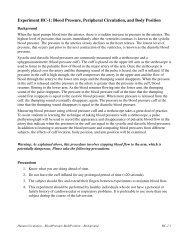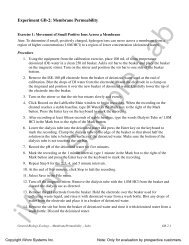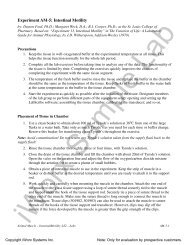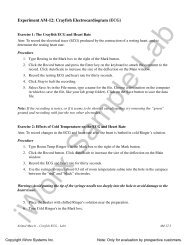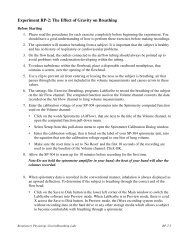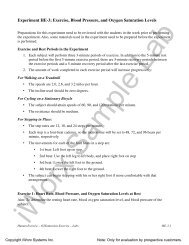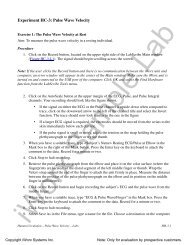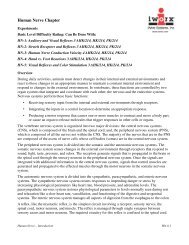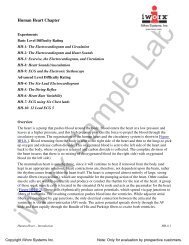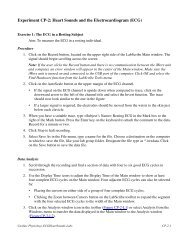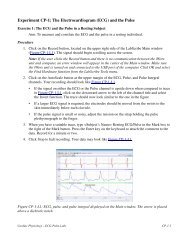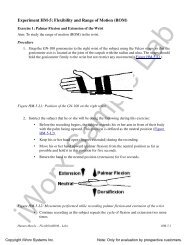Experiment HN-4: Hand vs. Foot Reactions - iWorx
Experiment HN-4: Hand vs. Foot Reactions - iWorx
Experiment HN-4: Hand vs. Foot Reactions - iWorx
- No tags were found...
Create successful ePaper yourself
Turn your PDF publications into a flip-book with our unique Google optimized e-Paper software.
Data Analysis1. Use the same technique explained in Exercise 1 to measure and record the reaction times of thesubject presented with auditory cues and responding using a hand switch.2. Enter the mean reaction time for this exercise in Table <strong>HN</strong>-4-L1.Questions1. How does the subject’s mean reaction time to visual cues compare to his or her mean reactiontime to auditory cues?2. What would cause a longer reaction time to one type of cue as compared to another?3. How do your subject’s mean reaction times compare to those of other subjects?4. Do all subjects respond more quickly to the same cue?Exercise 3: Eye-<strong>Foot</strong> Reaction TimesAim: To measure the reaction time of a subject to a visual cue when responding with the foot.Figure <strong>HN</strong>-4-L5: The FRS-100 foot reaction switch.Procedure1. Plug the DIN8 connector on the cable of the FRS-100 foot reaction switch (Figure <strong>HN</strong>-4-L5)into the Channel 4 input of the IWX/214 (Figure <strong>HN</strong>-4-L6) or Channel A5 of the IXTA ((Figure<strong>HN</strong>-4-L7) .2. Instruct the subject to:• Sit in a chair and face the computer screen.• Position a foot on the FRS-100 foot reaction switch in a manner that enables the subjectto press the pedal with his or her foot as quickly as possible.<strong>iWorx</strong> Sample LabHuman Nerve – <strong>Hand</strong> Vs. <strong>Foot</strong> <strong>Reactions</strong> – Labs<strong>HN</strong>-4-5Copyright <strong>iWorx</strong> Systems Inc.Note: Only for evaluation by prospective customers.
• Watch the right side of the computer screen and quickly press the pedal when the signalgenerated by the event marker first appears on the screen.3. Out of sight of the subject, another student should prepare to quietly press and release thebutton of the event marker. In this exercise, the subject will perform ten trials.Figure <strong>HN</strong>-4-L6: The EM-100 event marker and FRS-100 foot reaction switch connected to anIWX/214.Figure <strong>HN</strong>-4-L7: The EM-100 event marker and FRS-100 foot reaction switch connected to anIWX/214.<strong>iWorx</strong> Sample LabHuman Nerve – <strong>Hand</strong> Vs. <strong>Foot</strong> <strong>Reactions</strong> – Labs<strong>HN</strong>-4-6Copyright <strong>iWorx</strong> Systems Inc.Note: Only for evaluation by prospective customers.
Warning: In this exercise, it is important to press and release the button of the event marker quietlybecause any sound could be used by the subject as a cue.4. Type Visual Cues-<strong>Foot</strong> in the Mark box that is to the right of the Mark button.5. Click on the Record button. Instruct the subject to press the pedal as soon as he or she sees thevisual cue on the right side of the computer screen6. Instruct the subject that the exercise has begun and that a visual cue could appear on the screenat any time7. Use the event marker to deliver ten visual cues to the subject. The cues should not be less thanfive seconds nor more than ten seconds apart.8. After the tenth cue, click Stop to halt recording.9. Select Save in the File menu.Data Analysis1. In Exercises 3 and 4, the response of the subject in marked on the Response channel by the useof the foot pedal. To measure the reaction time of the subject in Exercises 3 and 4, use thecursors to measure the time between the onset of the signal from the EM-100 event markerrecorded on the Stimulus channel and the onset of signal from the FRS-100 foot reaction switchrecorded on the Response channel (Figure <strong>HN</strong>-4-L7).Figure <strong>HN</strong>-4-L7: A visual cue on the Stimulus channel, followed by the subject’s response using theFRS-100 foot reaction switch on the Response channel, are displayed on the Analysis window. The twocursors are positioned at the beginnings of the visual cue and the response signal for measurement ofthe subject’s reaction time (T2-T1) in this trial, 0.240 sec.<strong>iWorx</strong> Sample LabHuman Nerve – <strong>Hand</strong> Vs. <strong>Foot</strong> <strong>Reactions</strong> – Labs<strong>HN</strong>-4-7Copyright <strong>iWorx</strong> Systems Inc.Note: Only for evaluation by prospective customers.
2. Use the techniques explained in Exercise 1 to measure and record the reaction times of thesubject presented with a visual cue and responding using a foot switch.3. Enter the mean reaction time for this exercise in Table <strong>HN</strong>-4- L1.Exercise 4: Ear-<strong>Foot</strong> Reaction TimesAim: To measure the reaction time of a subject to a auditory cue when responding with the foot.Procedure1. Cover the computer screen with an opaque piece of construction paper to prevent the subjectfrom seeing any signal on the screen as a visual cue.2. Instruct the subject to:• Sit in a chair and face the computer screen.• Position a foot on the FRS-100 foot reaction switch in a manner that enables the subjectto press the pedal with his or her foot as quickly as possible.• Listen for the click (sound) of the event marker as the other student presses the buttonand then press the pedal as quickly as possible.3. Out of sight of the subject, another student should prepare to sharply tap the button of the eventmarker to create a auditory cue that is also recorded as a signal on the Stimulus channel. In thisexercise, the subject will perform ten trials.4. Type Auditory Cues-<strong>Foot</strong> in the Mark box that is to the right of the Mark button.5. Click on the Record button. Instruct the subject to press the pedal as soon as he or she hears theauditory cue.6. Instruct the subject that the exercise has begun and that an auditory cue could heard at any time7. Use the event marker to deliver ten auditory cues to the subject. The cues should not be lessthan five seconds nor more than ten seconds apart.8. After the tenth cue, click Stop to halt recording.9. Select Save in the File menu.Data Analysis1. Use the same technique explained in Exercise 3to measure and record the reaction times of thesubject presented with an auditory cue and responding using the foot.2. Enter the mean reaction time for this exercise in the table.<strong>iWorx</strong> Sample LabHuman Nerve – <strong>Hand</strong> Vs. <strong>Foot</strong> <strong>Reactions</strong> – Labs<strong>HN</strong>-4-8Copyright <strong>iWorx</strong> Systems Inc.Note: Only for evaluation by prospective customers.
Table <strong>HN</strong>-4-L1: Mean Reaction Times for Different Cues and Reactors.CueVisualAuditoryVisualAuditoryReactor<strong>Hand</strong><strong>Hand</strong><strong>Foot</strong><strong>Foot</strong>Mean ReactionTime of YourSubject (ms)Mean ReactionTime of AllSubjects (ms)Shortest MeanReaction Time inClass (ms)Longest MeanReaction Time inClass (ms)<strong>iWorx</strong> Sample LabHuman Nerve – <strong>Hand</strong> Vs. <strong>Foot</strong> <strong>Reactions</strong> – Labs<strong>HN</strong>-4-9Copyright <strong>iWorx</strong> Systems Inc.Note: Only for evaluation by prospective customers.



